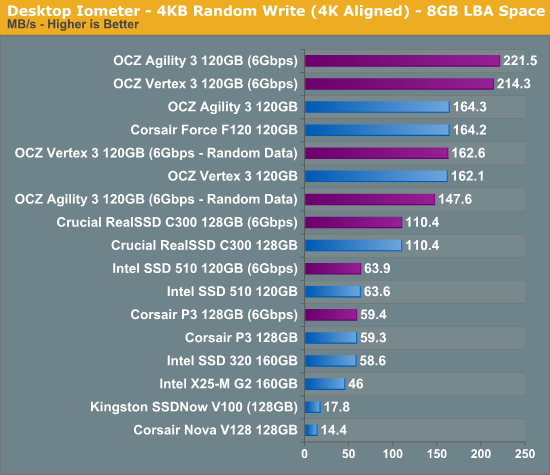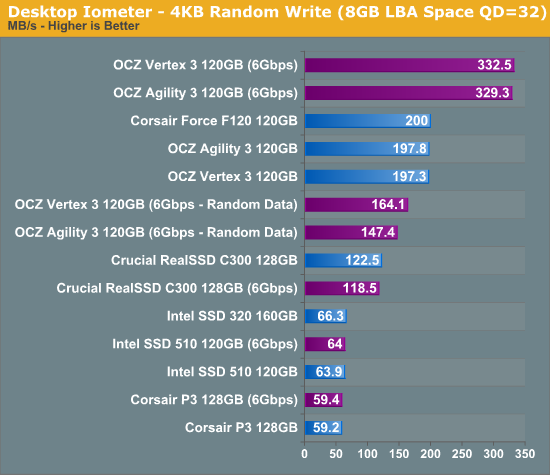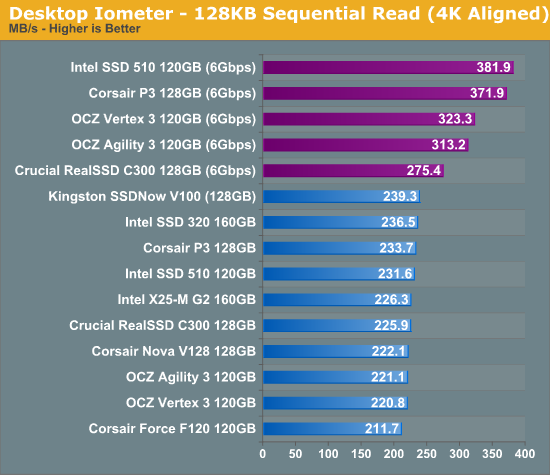The 2011 Mid-Range SSD Roundup: 120GB Agility 3, Intel 510 and More Compared
by Anand Lal Shimpi on June 7, 2011 12:52 PM ESTRandom Read/Write Speed
The four corners of SSD performance are as follows: random read, random write, sequential read and sequential write speed. Random accesses are generally small in size, while sequential accesses tend to be larger and thus we have the four Iometer tests we use in all of our reviews.
Our first test writes 4KB in a completely random pattern over an 8GB space of the drive to simulate the sort of random access that you'd see on an OS drive (even this is more stressful than a normal desktop user would see). I perform three concurrent IOs and run the test for 3 minutes. The results reported are in average MB/s over the entire time. We use both standard pseudo randomly generated data for each write as well as fully random data to show you both the maximum and minimum performance offered by SandForce based drives in these tests. The average performance of SF drives will likely be somewhere in between the two values for each drive you see in the graphs. For an understanding of why this matters, read our original SandForce article.

At worst, SandForce's small file random write performance is equal to its closest competitors, but at best it is significantly greater. Both the Vertex 3 and Agility 3 take the cake here. The Marvell based solutions are significantly slower, however we'll see if that matters in the real world tests.
Many of you have asked for random write performance at higher queue depths. What I have below is our 4KB random write test performed at a queue depth of 32 instead of 3. While the vast majority of desktop usage models experience queue depths of 0 - 5, higher depths are possible in heavy I/O (and multi-user) workloads:

At higher queue depths the advantage just grows for the SF-2281 drives.

Crucial optimized very heavily for random read performance, and to this day nothing (even the replacement m4/C400) can outperform the C300 in our small file random read test. Intel's SSD 510 is the next fastest 6Gbps drive we've got here, followed by the P3 and eventually the Vertex 3/Agility 3.
Sequential Read/Write Speed
To measure sequential performance I ran a 1 minute long 128KB sequential test over the entire span of the drive at a queue depth of 1. The results reported are in average MB/s over the entire test length.

To post high sequential read speeds you need to have a 6Gbps interface these days. Armed with one the Intel SSD 510 and Corsair P3 both post the highest scores here. Even the Vertex 3/Agility 3 are a bit behind the two Marvell drives.

Sequential write performance is another story entirely. With highly compressible data the Vertex 3 is untouched and even in the worst case it's still among the fastest drives. I'll chalk this one up as a win for OCZ, however the rest of the competitors do well here.










68 Comments
View All Comments
icrf - Wednesday, June 8, 2011 - link
Don't forget the Corsair Force Series 3. The manufacturer announced specs are very impressive. We just need it in Anand's hands to see how honest they are.I'm trying to decide between the Vertex 3, Force Series 3, and M4 @ 120 GB. I've seen some of those other reviews on the M4, and it really does seem like it degrades more gracefully than anyone else with the capacity drop, so it could be a real contender @ 120 GB.
DigitalFreak - Tuesday, June 7, 2011 - link
"Combine that with Intel's track record for reliability"Hasn't Intel had multiple issues with their drives that caused data loss?
Anand Lal Shimpi - Tuesday, June 7, 2011 - link
All of the SSD vendors have had issues of one form or another, Intel seems to have the lowest return rates however (at least based on the only published data at this point - it is supported by the failures I've noticed first hand however).MrAv8er - Tuesday, June 7, 2011 - link
Yes they have their issues. And the reliability question between the Vertex 3 and the Intel 510 is an interesting one. I just bought an I510 120GB over the Vertex 3 because of the reviews posted at Newegg. Complaints ran in the high teens for total failures, which I found too distastfull to accept, therefore I opted to go Intel which faired much better in the reviews. HOWEVER, that being said, I had an 80GB Intel G1 in my rig running Vista 64 coming up 2 years ago. It bricked itself at about the 7 week mark. Intel eventually replaced it, but the whole process took over 3 weeks.zhill - Tuesday, June 7, 2011 - link
Good review, another set of excellent data points when considering SSDs. I am actually torn between the older Vertex 2 240GB ($390 on amazon, or $1.6/GB) and a new drive like the 320 300GB or 510 250GB, it will be slower, but for the price it's a sweet deal--as long as it actually works and doesn't become a brick.I would be interested in seeing a power consumption graph for the entire StorageBench (or maybe just the light workload) run on each drive. I just wonder to what extent "speed to idle" impacts SSDs as it does in CPUs. It may be that the changes from load to idle are too slow to seriously affect the overall power draw, but that could also very by manufacturer. I think that would give a better perspective on the power story than just the idle and load numbers.
casteve - Tuesday, June 7, 2011 - link
~120GB is the sweet spot for speed/price. Glad to see some maturation in performance - now we can pretty much pick based on firmware maturity/stability and product reliability.jwilliams4200 - Tuesday, June 7, 2011 - link
ANAND:Isn't the flash on the back of the Intel 320 board likely used for the XOR parity / RAID-4-like feature of the 320 series? I'm not sure why you did not mention that....
24 db/octave - Tuesday, June 7, 2011 - link
With all the various benchmarks available, which is the closest one that would best predict performance as a Photoshop scratch drive? (Not the Windows or application drive.) I think for Photoshop scratch, it is sequential uncompressed writes & reads, that matters most, but I'm not positive.Thanks, Alan
buzznut - Tuesday, June 7, 2011 - link
I also wanted to add my thanks for continually providing the most comprehensive and pertinent coverage of SSDs. Certainly right now the 120GB range hits the sweet spot for performance/real estate/value. I have not seen much coverage of the corsair drives yet, so this is great. Bigger drives are prohibitively expensive for the average user. But current drives are more useful than as just boot drives, it makes sense to have enough room to put your favorite programs on.I still think the Vertex3 is the choice for enthusiasts, although its nice to see that intel is still making excellent drives where reliability is key. I am hoping to pick up a vertex3 in the fall after bulldozer hits the desktop. I am sure that firmware will mature by then.
GrizzledYoungMan - Tuesday, June 7, 2011 - link
Question!Would appreciate thoughts on this. I'm on a P55 motherboard, with a free x16 slot. If I wanted to use one of the 6Gbps drives with an add-in controller, what sort of performance hit would I be looking at, best case scenario? And which add-in card to use?
Thanks! Also, this review was pretty darned useful. Bravo.